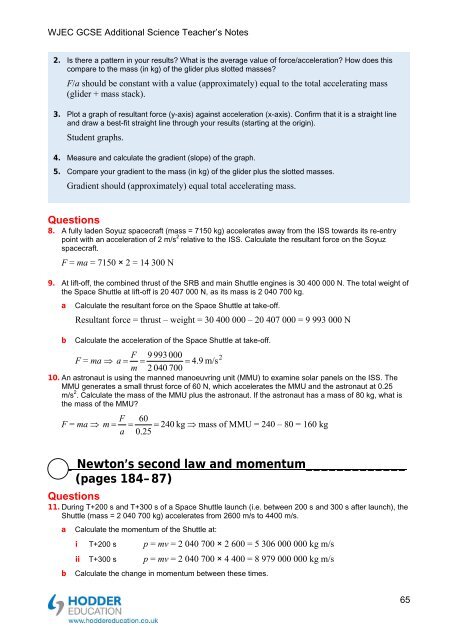Teacher's notes and answers to questions in the book - Hodder Plus ...
Teacher's notes and answers to questions in the book - Hodder Plus ...
Teacher's notes and answers to questions in the book - Hodder Plus ...
Create successful ePaper yourself
Turn your PDF publications into a flip-book with our unique Google optimized e-Paper software.
WJEC GCSE Additional Science Teacher’s Notes<br />
2. Is <strong>the</strong>re a pattern <strong>in</strong> your results What is <strong>the</strong> average value of force/acceleration How does this<br />
compare <strong>to</strong> <strong>the</strong> mass (<strong>in</strong> kg) of <strong>the</strong> glider plus slotted masses<br />
F/a should be constant with a value (approximately) equal <strong>to</strong> <strong>the</strong> <strong>to</strong>tal accelerat<strong>in</strong>g mass<br />
(glider + mass stack).<br />
3. Plot a graph of resultant force (y-axis) aga<strong>in</strong>st acceleration (x-axis). Confirm that it is a straight l<strong>in</strong>e<br />
<strong>and</strong> draw a best-fit straight l<strong>in</strong>e through your results (start<strong>in</strong>g at <strong>the</strong> orig<strong>in</strong>).<br />
Student graphs.<br />
4. Measure <strong>and</strong> calculate <strong>the</strong> gradient (slope) of <strong>the</strong> graph.<br />
5. Compare your gradient <strong>to</strong> <strong>the</strong> mass (<strong>in</strong> kg) of <strong>the</strong> glider plus <strong>the</strong> slotted masses.<br />
Gradient should (approximately) equal <strong>to</strong>tal accelerat<strong>in</strong>g mass.<br />
Questions<br />
8. A fully laden Soyuz spacecraft (mass = 7150 kg) accelerates away from <strong>the</strong> ISS <strong>to</strong>wards its re-entry<br />
po<strong>in</strong>t with an acceleration of 2 m/s 2 relative <strong>to</strong> <strong>the</strong> ISS. Calculate <strong>the</strong> resultant force on <strong>the</strong> Soyuz<br />
spacecraft.<br />
F = ma = 7150 × 2 = 14 300 N<br />
9. At lift-off, <strong>the</strong> comb<strong>in</strong>ed thrust of <strong>the</strong> SRB <strong>and</strong> ma<strong>in</strong> Shuttle eng<strong>in</strong>es is 30 400 000 N. The <strong>to</strong>tal weight of<br />
<strong>the</strong> Space Shuttle at lift-off is 20 407 000 N, as its mass is 2 040 700 kg.<br />
a Calculate <strong>the</strong> resultant force on <strong>the</strong> Space Shuttle at take-off.<br />
Resultant force = thrust – weight = 30 400 000 – 20 407 000 = 9 993 000 N<br />
b Calculate <strong>the</strong> acceleration of <strong>the</strong> Space Shuttle at take-off.<br />
F = ma <br />
F<br />
a m<br />
<br />
9 993 000<br />
2 040 700<br />
4.9 m/s<br />
2<br />
10. An astronaut is us<strong>in</strong>g <strong>the</strong> manned manoeuvr<strong>in</strong>g unit (MMU) <strong>to</strong> exam<strong>in</strong>e solar panels on <strong>the</strong> ISS. The<br />
MMU generates a small thrust force of 60 N, which accelerates <strong>the</strong> MMU <strong>and</strong> <strong>the</strong> astronaut at 0.25<br />
m/s 2 . Calculate <strong>the</strong> mass of <strong>the</strong> MMU plus <strong>the</strong> astronaut. If <strong>the</strong> astronaut has a mass of 80 kg, what is<br />
<strong>the</strong> mass of <strong>the</strong> MMU<br />
F = ma <br />
F<br />
m a<br />
60 240 kg mass of MMU = 240 – 80 = 160 kg<br />
0.25<br />
_ New<strong>to</strong>n’s second law <strong>and</strong> momentum_____________<br />
(pages 184–87)<br />
Questions<br />
11. Dur<strong>in</strong>g T+200 s <strong>and</strong> T+300 s of a Space Shuttle launch (i.e. between 200 s <strong>and</strong> 300 s after launch), <strong>the</strong><br />
Shuttle (mass = 2 040 700 kg) accelerates from 2600 m/s <strong>to</strong> 4400 m/s.<br />
a Calculate <strong>the</strong> momentum of <strong>the</strong> Shuttle at:<br />
i T+200 s p = mv = 2 040 700 × 2 600 = 5 306 000 000 kg m/s<br />
ii T+300 s p = mv = 2 040 700 × 4 400 = 8 979 000 000 kg m/s<br />
b Calculate <strong>the</strong> change <strong>in</strong> momentum between <strong>the</strong>se times.<br />
65

















